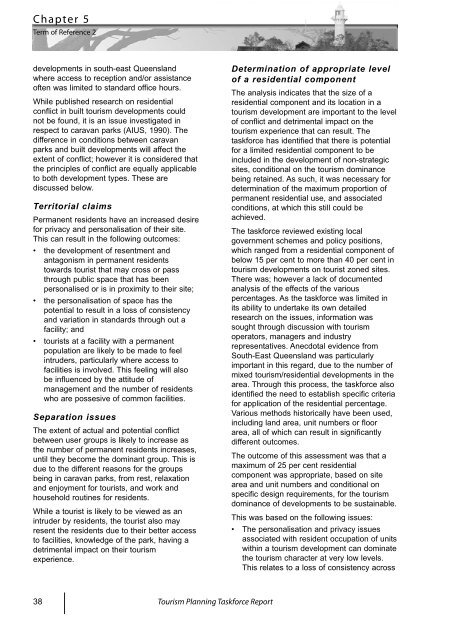Tourism Planning Taskforce Report - Western Australian Planning ...
Tourism Planning Taskforce Report - Western Australian Planning ...
Tourism Planning Taskforce Report - Western Australian Planning ...
- No tags were found...
Create successful ePaper yourself
Turn your PDF publications into a flip-book with our unique Google optimized e-Paper software.
Chapter 5Term of Reference 2developments in south-east Queenslandwhere access to reception and/or assistanceoften was limited to standard office hours.While published research on residentialconflict in built tourism developments couldnot be found, it is an issue investigated inrespect to caravan parks (AIUS, 1990). Thedifference in conditions between caravanparks and built developments will affect theextent of conflict; however it is considered thatthe principles of conflict are equally applicableto both development types. These arediscussed below.Territorial claimsPermanent residents have an increased desirefor privacy and personalisation of their site.This can result in the following outcomes:• the development of resentment andantagonism in permanent residentstowards tourist that may cross or passthrough public space that has beenpersonalised or is in proximity to their site;• the personalisation of space has thepotential to result in a loss of consistencyand variation in standards through out afacility; and• tourists at a facility with a permanentpopulation are likely to be made to feelintruders, particularly where access tofacilities is involved. This feeling will alsobe influenced by the attitude ofmanagement and the number of residentswho are possesive of common facilities.Separation issuesThe extent of actual and potential conflictbetween user groups is likely to increase asthe number of permanent residents increases,until they become the dominant group. This isdue to the different reasons for the groupsbeing in caravan parks, from rest, relaxationand enjoyment for tourists, and work andhousehold routines for residents.While a tourist is likely to be viewed as anintruder by residents, the tourist also mayresent the residents due to their better accessto facilities, knowledge of the park, having adetrimental impact on their tourismexperience.Determination of appropriate levelof a residential componentThe analysis indicates that the size of aresidential component and its location in atourism development are important to the levelof conflict and detrimental impact on thetourism experience that can result. Thetaskforce has identified that there is potentialfor a limited residential component to beincluded in the development of non-strategicsites, conditional on the tourism dominancebeing retained. As such, it was necessary fordetermination of the maximum proportion ofpermanent residential use, and associatedconditions, at which this still could beachieved.The taskforce reviewed existing localgovernment schemes and policy positions,which ranged from a residential component ofbelow 15 per cent to more than 40 per cent intourism developments on tourist zoned sites.There was; however a lack of documentedanalysis of the effects of the variouspercentages. As the taskforce was limited inits ability to undertake its own detailedresearch on the issues, information wassought through discussion with tourismoperators, managers and industryrepresentatives. Anecdotal evidence fromSouth-East Queensland was particularlyimportant in this regard, due to the number ofmixed tourism/residential developments in thearea. Through this process, the taskforce alsoidentified the need to establish specific criteriafor application of the residential percentage.Various methods historically have been used,including land area, unit numbers or floorarea, all of which can result in significantlydifferent outcomes.The outcome of this assessment was that amaximum of 25 per cent residentialcomponent was appropriate, based on sitearea and unit numbers and conditional onspecific design requirements, for the tourismdominance of developments to be sustainable.This was based on the following issues:• The personalisation and privacy issuesassociated with resident occupation of unitswithin a tourism development can dominatethe tourism character at very low levels.This relates to a loss of consistency across38 <strong>Tourism</strong> <strong>Planning</strong> <strong>Taskforce</strong> <strong>Report</strong>

















